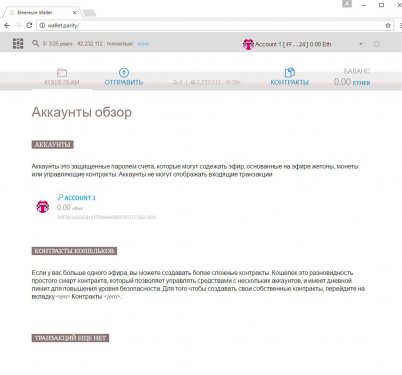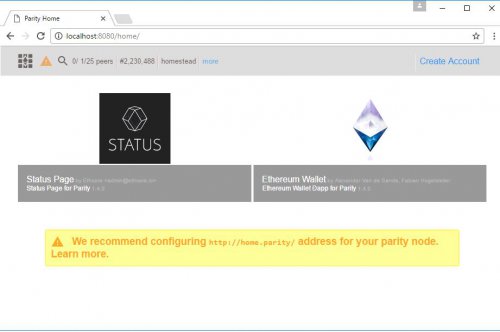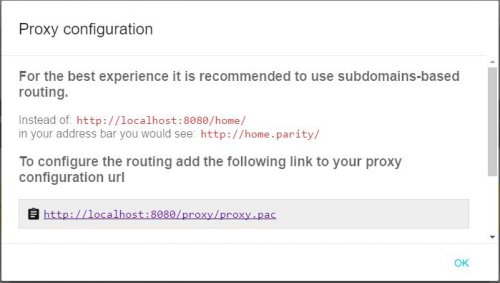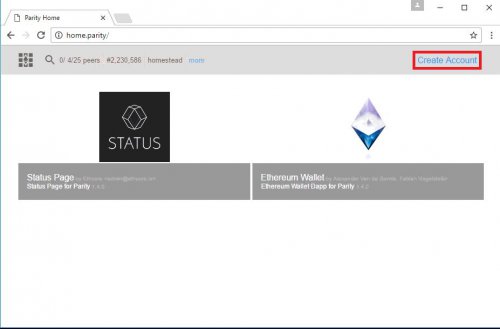igorwhite’s блог
Ethcore Parity в качестве основного кошелька на примере Ethereum Classic
Запись опубликована igorwhite · 10 сен 2016, 19:13
19 220 просмотров
Инструкция по использованию Parity в качестве основного кошелька Ethereum Classic.
Я знаю, что многие майнеры в том числе и кто майнит у меня на ПУЛАХ используют биржевые кошельки вместо локальных кошельков, но я не сторонник такого решения и особенно не рекомендую новичкам.
Я уже пережил два уполовинивания Bitcoin и крах нескольких бирж Mt.Gox, Cryptsy с монетами пользователей.
И еще биржа, которая почти на грани — BitFenix.
Parity быстрый легковесный кошелек в отличии от Mist (geth)
И так приступим. Инструкция для Windows. Для Linux и Mac OS аналогично.
Переходим на сайт https://ethcore.io/ скачиваем Parity или ниже прямая ссылка.
Устанавливаем. Установка займет несколько секунд.
Идем в папку с установленной Parity по пути:
Создаем ярлык parity.exe и размещаем его на рабочем столе.
Идем в свойства ярлыка и дописываем параметры запуска Parity.
Поле объект должно выглядеть так:
Там же можно сменить значок ярлыка.
После этого можно запустить Parity через ярлык. Начнется синхронизация Parity. Это займет некоторое время.
Если ждать лень то вот ссылки на блокчейн:
Ethereum Ckassic от 10.09.2016 г. >>> MEGA
Ethereum от 18.09.2016 г. >>> MEGA
Распаковать архив в папку .parity
Дальше устанавливаем по умолчанию браузер Chrome. И идем по адресу:
Загружаемся в наш кошелек Ethereum Classic
Выполним рекомендации по proxy:
Идем в Настройки Chrome >> Показать дополнительные настройки >> Сеть >> Изменить настройки прокси-сервера .
Откроются свойства интернет Идем — Настройка сети откроется Настройка параметров локальной сети
Активировать: Использовать сценарий автоматической настройки и внести туда:
Сохраниться и выйти.
После этого заходим в браузер:
Создаем новый аккаунт >> Create Account:
Нужно внести пароль. Придумайте сложный пароль или воспользуйтесь Генератором Паролей. Не забудьте его.
Собственно все можно пользоваться.
Можно еще добавить в ярлык запуска Parity ключи —dapps-user и —dapps-pass для дополнительной безопасности. Тогда привходе в браузере будет дополнительно запрашиваться Пользователь и Пароль.
Полный список параметров Parity под спойлером:
MODE Set the operating mode. MODE can be one of:
active — Parity continuously syncs the chain.
passive — Parity syncs initially, then sleeps and
wakes regularly to resync.
dark — Parity syncs only when an external interface
is active. [default: active].
Specify the number of seconds before inactivity
timeout occurs when mode is dark or passive
Specify the number of seconds before auto sleep
reawake timeout occurs when mode is passive
Specify the blockchain type. CHAIN may be either a
JSON chain specification file or olympic, frontier,
homestead, mainnet, morden, classic or testnet
Specify the database & configuration directory path
Specify the path for JSON key files to be found
Specify your node’s name.
Unlock ACCOUNTS for the duration of the execution.
ACCOUNTS is a comma-delimited list of addresses.
Provide a file containing a password for unlocking an account.
Specify the number of iterations to use when
deriving key from the password (bigger is more secure) [default: 10240].
Do not import keys from legacy clients.
Enable Trusted Signer WebSocket endpoint used by Signer UIs, even when —unlock is in use.
Trusted Signer WebSocket endpoint used by Signer UIs.
Specify the port of Trusted Signer server [default: 8180].
Specify directory where Signer UIs tokens should be stored. [default: $HOME/.parity/signer]
Disable Origin and Host headers validation for
Trusted Signer. WARNING: INSECURE. Used only for development.
Disable p2p networking.
Override the port on which the node should listen [default: 30303].
Try to maintain at least NUM peers [default: 25].
Allow up to that many peers [default: 50].
Specify method to use for determining public
address. Must be one of: any, none, upnp, extip: [default: any].
Override the network identifier from the chain we are on.
Override the bootnodes from our chain. NODES should
be comma-delimited enodes.
Disable new peer discovery.
Specify node secret key, either as 64-character hex
string or input to SHA3 operation.
Provide a file containing enodes, one per line.
These nodes will always have a reserved slot on top
of the normal maximum peers.
Connect only to reserved nodes.
API and Console Options:
Disable the JSON-RPC API server.
Specify the port portion of the JSONRPC API server [default: 8545].
Specify the hostname portion of the JSONRPC API
server, IP should be an interface’s IP address, or
all (all interfaces) or local [default: local].
Specify CORS header for JSON-RPC API responses.
Specify the APIs available through the JSONRPC
interface. APIS is a comma-delimited list of API
name. Possible name are web3, eth, net, personal,
ethcore, ethcore_set, traces, rpc.
List of allowed Host header values. This option will
validate the Host header sent by the browser, it
is additional security against some attack
vectors. Special options: «all», «none»,
Disable JSON-RPC over IPC service.
Specify custom path for JSON-RPC over IPC service
Specify custom API set available via JSON-RPC over
IPC [default: web3,eth,net,ethcore,personal,traces,rpc].
Disable the Dapps server (e.g. status page).
Specify the port portion of the Dapps server [default: 8080].
Specify the hostname portion of the Dapps
server, IP should be an interface’s IP address, or local [default: local].
Specify username for Dapps server. It will be
used in HTTP Basic Authentication Scheme.
If —dapps-pass is not specified you will be asked for password on startup.
Specify password for Dapps server. Use only in conjunction with —dapps-user.
—dapps-path PATH Specify directory where dapps should be installed. [default: $HOME/.parity/dapps]
Specify the block author (aka «coinbase») address for sending block rewards from sealed blocks.
NOTE: MINING WILL NOT WORK WITHOUT THIS OPTION.
Force the node to author new blocks as if it were always sealing/mining.
Specify which transactions should force the node to reseal a block. SET is one of:
none — never reseal on new transactions;
own — reseal only on a new local transaction;
ext — reseal only on a new external transaction;
all — reseal on all new transactions [default: own].
Specify the minimum time between reseals from incoming transactions. MS is time measured in
milliseconds [default: 2000].
Specify the number of historical work packages
which are kept cached lest a solution is found for
them later. High values take more memory but result
in fewer unusable solutions [default: 20].
Apply a limit of GAS as the maximum amount of gas a single transaction may have for it to be mined.
Set of transactions to relay. SET may be:
cheap — Relay any transaction in the queue (this
may include invalid transactions);
strict — Relay only executed transactions (this
guarantees we don’t relay invalid transactions, but
means we relay nothing if not mining);
lenient — Same as strict when mining, and cheap
when not [default: cheap].
Amount of USD to be paid for a basic transaction
[default: 0.005]. The minimum gas price is set
USD value of a single ETH. SOURCE may be either an
amount in USD, a web service or ‘auto’ to use each
web service in turn and fallback on the last known
good value [default: auto].
T will be allowed to pass between each gas price
update. T may be daily, hourly, a number of seconds,
or a time string of the form «2 days», «30 minutes»
etc. [default: hourly].
Amount of gas per block to target when sealing a new block [default: 4700000].
—gas-cap GAS A cap on how large we will raise the gas limit per
block due to transaction volume [default: 6283184].
Specify a custom extra-data for authored blocks, no more than 32 characters.
LIMIT Maximum amount of transactions in the queue (waiting
to be included in next block) [default: 1024].
Move solved blocks from the work package queue
instead of cloning them. This gives a slightly
faster import speed, but means that extra solutions
submitted for the same work package will go unused.
URLs to which work package notifications are pushed.
URLS should be a comma-delimited list of HTTP URLs.
Indicates if full transaction tracing should be
enabled. Works only if client had been fully synced
with tracing enabled. BOOL may be one of auto, on,
off. auto uses last used value of this option (off
if it does not exist) [default: auto].
Configure pruning of the state/storage trie. METHOD
may be one of auto, archive, fast:
archive — keep all state trie data. No pruning.
fast — maintain journal overlay. Fast but 50MB used.
auto — use the method most recently synced or
default to fast if none synced [default: auto].
Override database cache size [default: 64].
Specify the prefered size of the blockchain cache in megabytes [default: 8].
Specify the maximum size of memory to use for block queue [default: 50].
Set total amount of discretionary memory to use for
the entire system, overrides other cache and queueoptions.
Disables DB WAL, which gives a significant speed up
but means an unclean exit is unrecoverable.
Database compaction type. TYPE may be one of:
ssd — suitable for SSDs and fast HDDs;
hdd — suitable for slow HDDs [default: ssd].
—fat-db Fat database.
Export from block BLOCK, which may be an index or hash [default: 1].
Export to (including) block BLOCK, which may be an
index, hash or ‘latest’ [default: latest].
For import/export in given format. FORMAT must be
one of ‘hex’ and ‘binary’.
Take a snapshot at the given block, which may be an
index, hash, or ‘latest’. Note that taking snapshots at
non-recent blocks will only work with —pruning archive
Virtual Machine Options:
—jitvm Enable the JIT VM.
Run in Geth-compatibility mode. Sets the IPC path
to be the same as Geth’s. Overrides the —ipc-path
and —ipcpath options. Alters RPCs to reflect Geth
Geth-compatible testnet mode. Equivalent to —chain
testnet —keys-path $HOME/parity/testnet-keys.
Overrides the —keys-path option.
Equivalent to —db-path PATH.
Equivalent to —network-id INDEX.
Equivalent to —min-peers NUM.
Equivalent to —node-key KEY.
Equivalent to —no-discovery.
Does nothing; JSON-RPC is on by default now.
Equivalent to —no-jsonrpc.
Does nothing; dapps server is on by default now.
Equivalent to —no-dapps.
Does nothing; JSON-RPC is on by default now.
Equivalent to —jsonrpc-interface IP.
Equivalent to —jsonrpc-port PORT.
Equivalent to —jsonrpc-apis APIS.
Equivalent to —jsonrpc-cors URL.
Equivalent to —no-ipc.
Equivalent to —no-ipc.
Equivalent to —ipc-apis APIS.
Equivalent to —ipc-path PATH.
Minimum amount of Wei per GAS to be paid for a
transaction to be accepted for mining. Overrides —basic-tx-usd.
Equivalent to —author ADDRESS.
Equivalent to —extra-data STRING.
Equivalent to —cache-size MB.
-l —logging LOGGING
Specify the logging level. Must conform to the same format as RUST_LOG.
Specify a filename into which logging should be directed.
Don’t use terminal color codes in output.
Show information about version.
Show this screen.
И Добро Пожаловать ко мне на пулы Ethereum Classic и Ethereum
igorwhite’s блог
Ethcore Parity в качестве основного кошелька на примере Ethereum Classic
Запись опубликована igorwhite · 10 сен 2016, 19:13
19 220 просмотров
Инструкция по использованию Parity в качестве основного кошелька Ethereum Classic.
Я знаю, что многие майнеры в том числе и кто майнит у меня на ПУЛАХ используют биржевые кошельки вместо локальных кошельков, но я не сторонник такого решения и особенно не рекомендую новичкам.
Я уже пережил два уполовинивания Bitcoin и крах нескольких бирж Mt.Gox, Cryptsy с монетами пользователей.
И еще биржа, которая почти на грани — BitFenix.
Parity быстрый легковесный кошелек в отличии от Mist (geth)
И так приступим. Инструкция для Windows. Для Linux и Mac OS аналогично.
Переходим на сайт https://ethcore.io/ скачиваем Parity или ниже прямая ссылка.
Устанавливаем. Установка займет несколько секунд.
Идем в папку с установленной Parity по пути:
Создаем ярлык parity.exe и размещаем его на рабочем столе.
Идем в свойства ярлыка и дописываем параметры запуска Parity.
Поле объект должно выглядеть так:
Там же можно сменить значок ярлыка.
После этого можно запустить Parity через ярлык. Начнется синхронизация Parity. Это займет некоторое время.
Если ждать лень то вот ссылки на блокчейн:
Ethereum Ckassic от 10.09.2016 г. >>> MEGA
Ethereum от 18.09.2016 г. >>> MEGA
Распаковать архив в папку .parity
Дальше устанавливаем по умолчанию браузер Chrome. И идем по адресу:
Загружаемся в наш кошелек Ethereum Classic
Выполним рекомендации по proxy:
Идем в Настройки Chrome >> Показать дополнительные настройки >> Сеть >> Изменить настройки прокси-сервера .
Откроются свойства интернет Идем — Настройка сети откроется Настройка параметров локальной сети
Активировать: Использовать сценарий автоматической настройки и внести туда:
Сохраниться и выйти.
После этого заходим в браузер:
Создаем новый аккаунт >> Create Account:
Нужно внести пароль. Придумайте сложный пароль или воспользуйтесь Генератором Паролей. Не забудьте его.
Собственно все можно пользоваться.
Можно еще добавить в ярлык запуска Parity ключи —dapps-user и —dapps-pass для дополнительной безопасности. Тогда привходе в браузере будет дополнительно запрашиваться Пользователь и Пароль.
Полный список параметров Parity под спойлером:
MODE Set the operating mode. MODE can be one of:
active — Parity continuously syncs the chain.
passive — Parity syncs initially, then sleeps and
wakes regularly to resync.
dark — Parity syncs only when an external interface
is active. [default: active].
Specify the number of seconds before inactivity
timeout occurs when mode is dark or passive
Specify the number of seconds before auto sleep
reawake timeout occurs when mode is passive
Specify the blockchain type. CHAIN may be either a
JSON chain specification file or olympic, frontier,
homestead, mainnet, morden, classic or testnet
Specify the database & configuration directory path
Specify the path for JSON key files to be found
Specify your node’s name.
Unlock ACCOUNTS for the duration of the execution.
ACCOUNTS is a comma-delimited list of addresses.
Provide a file containing a password for unlocking an account.
Specify the number of iterations to use when
deriving key from the password (bigger is more secure) [default: 10240].
Do not import keys from legacy clients.
Enable Trusted Signer WebSocket endpoint used by Signer UIs, even when —unlock is in use.
Trusted Signer WebSocket endpoint used by Signer UIs.
Specify the port of Trusted Signer server [default: 8180].
Specify directory where Signer UIs tokens should be stored. [default: $HOME/.parity/signer]
Disable Origin and Host headers validation for
Trusted Signer. WARNING: INSECURE. Used only for development.
Disable p2p networking.
Override the port on which the node should listen [default: 30303].
Try to maintain at least NUM peers [default: 25].
Allow up to that many peers [default: 50].
Specify method to use for determining public
address. Must be one of: any, none, upnp, extip: [default: any].
Override the network identifier from the chain we are on.
Override the bootnodes from our chain. NODES should
be comma-delimited enodes.
Disable new peer discovery.
Specify node secret key, either as 64-character hex
string or input to SHA3 operation.
Provide a file containing enodes, one per line.
These nodes will always have a reserved slot on top
of the normal maximum peers.
Connect only to reserved nodes.
API and Console Options:
Disable the JSON-RPC API server.
Specify the port portion of the JSONRPC API server [default: 8545].
Specify the hostname portion of the JSONRPC API
server, IP should be an interface’s IP address, or
all (all interfaces) or local [default: local].
Specify CORS header for JSON-RPC API responses.
Specify the APIs available through the JSONRPC
interface. APIS is a comma-delimited list of API
name. Possible name are web3, eth, net, personal,
ethcore, ethcore_set, traces, rpc.
List of allowed Host header values. This option will
validate the Host header sent by the browser, it
is additional security against some attack
vectors. Special options: «all», «none»,
Disable JSON-RPC over IPC service.
Specify custom path for JSON-RPC over IPC service
Specify custom API set available via JSON-RPC over
IPC [default: web3,eth,net,ethcore,personal,traces,rpc].
Disable the Dapps server (e.g. status page).
Specify the port portion of the Dapps server [default: 8080].
Specify the hostname portion of the Dapps
server, IP should be an interface’s IP address, or local [default: local].
Specify username for Dapps server. It will be
used in HTTP Basic Authentication Scheme.
If —dapps-pass is not specified you will be asked for password on startup.
Specify password for Dapps server. Use only in conjunction with —dapps-user.
—dapps-path PATH Specify directory where dapps should be installed. [default: $HOME/.parity/dapps]
Specify the block author (aka «coinbase») address for sending block rewards from sealed blocks.
NOTE: MINING WILL NOT WORK WITHOUT THIS OPTION.
Force the node to author new blocks as if it were always sealing/mining.
Specify which transactions should force the node to reseal a block. SET is one of:
none — never reseal on new transactions;
own — reseal only on a new local transaction;
ext — reseal only on a new external transaction;
all — reseal on all new transactions [default: own].
Specify the minimum time between reseals from incoming transactions. MS is time measured in
milliseconds [default: 2000].
Specify the number of historical work packages
which are kept cached lest a solution is found for
them later. High values take more memory but result
in fewer unusable solutions [default: 20].
Apply a limit of GAS as the maximum amount of gas a single transaction may have for it to be mined.
Set of transactions to relay. SET may be:
cheap — Relay any transaction in the queue (this
may include invalid transactions);
strict — Relay only executed transactions (this
guarantees we don’t relay invalid transactions, but
means we relay nothing if not mining);
lenient — Same as strict when mining, and cheap
when not [default: cheap].
Amount of USD to be paid for a basic transaction
[default: 0.005]. The minimum gas price is set
USD value of a single ETH. SOURCE may be either an
amount in USD, a web service or ‘auto’ to use each
web service in turn and fallback on the last known
good value [default: auto].
T will be allowed to pass between each gas price
update. T may be daily, hourly, a number of seconds,
or a time string of the form «2 days», «30 minutes»
etc. [default: hourly].
Amount of gas per block to target when sealing a new block [default: 4700000].
—gas-cap GAS A cap on how large we will raise the gas limit per
block due to transaction volume [default: 6283184].
Specify a custom extra-data for authored blocks, no more than 32 characters.
LIMIT Maximum amount of transactions in the queue (waiting
to be included in next block) [default: 1024].
Move solved blocks from the work package queue
instead of cloning them. This gives a slightly
faster import speed, but means that extra solutions
submitted for the same work package will go unused.
URLs to which work package notifications are pushed.
URLS should be a comma-delimited list of HTTP URLs.
Indicates if full transaction tracing should be
enabled. Works only if client had been fully synced
with tracing enabled. BOOL may be one of auto, on,
off. auto uses last used value of this option (off
if it does not exist) [default: auto].
Configure pruning of the state/storage trie. METHOD
may be one of auto, archive, fast:
archive — keep all state trie data. No pruning.
fast — maintain journal overlay. Fast but 50MB used.
auto — use the method most recently synced or
default to fast if none synced [default: auto].
Override database cache size [default: 64].
Specify the prefered size of the blockchain cache in megabytes [default: 8].
Specify the maximum size of memory to use for block queue [default: 50].
Set total amount of discretionary memory to use for
the entire system, overrides other cache and queueoptions.
Disables DB WAL, which gives a significant speed up
but means an unclean exit is unrecoverable.
Database compaction type. TYPE may be one of:
ssd — suitable for SSDs and fast HDDs;
hdd — suitable for slow HDDs [default: ssd].
—fat-db Fat database.
Export from block BLOCK, which may be an index or hash [default: 1].
Export to (including) block BLOCK, which may be an
index, hash or ‘latest’ [default: latest].
For import/export in given format. FORMAT must be
one of ‘hex’ and ‘binary’.
Take a snapshot at the given block, which may be an
index, hash, or ‘latest’. Note that taking snapshots at
non-recent blocks will only work with —pruning archive
Virtual Machine Options:
—jitvm Enable the JIT VM.
Run in Geth-compatibility mode. Sets the IPC path
to be the same as Geth’s. Overrides the —ipc-path
and —ipcpath options. Alters RPCs to reflect Geth
Geth-compatible testnet mode. Equivalent to —chain
testnet —keys-path $HOME/parity/testnet-keys.
Overrides the —keys-path option.
Equivalent to —db-path PATH.
Equivalent to —network-id INDEX.
Equivalent to —min-peers NUM.
Equivalent to —node-key KEY.
Equivalent to —no-discovery.
Does nothing; JSON-RPC is on by default now.
Equivalent to —no-jsonrpc.
Does nothing; dapps server is on by default now.
Equivalent to —no-dapps.
Does nothing; JSON-RPC is on by default now.
Equivalent to —jsonrpc-interface IP.
Equivalent to —jsonrpc-port PORT.
Equivalent to —jsonrpc-apis APIS.
Equivalent to —jsonrpc-cors URL.
Equivalent to —no-ipc.
Equivalent to —no-ipc.
Equivalent to —ipc-apis APIS.
Equivalent to —ipc-path PATH.
Minimum amount of Wei per GAS to be paid for a
transaction to be accepted for mining. Overrides —basic-tx-usd.
Equivalent to —author ADDRESS.
Equivalent to —extra-data STRING.
Equivalent to —cache-size MB.
-l —logging LOGGING
Specify the logging level. Must conform to the same format as RUST_LOG.
Specify a filename into which logging should be directed.
Don’t use terminal color codes in output.
Show information about version.
Show this screen.
И Добро Пожаловать ко мне на пулы Ethereum Classic и Ethereum













